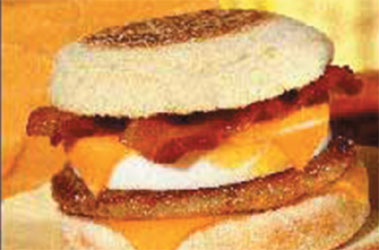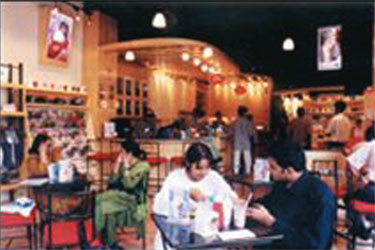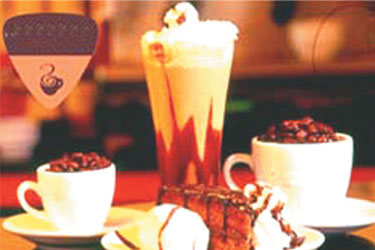| |
IT'S CHOWTIME FOLKS
As India’s GenNext goes restaurant hopping in a big way, marketers are introducing novel dining out concepts and brands that go beyond the traditional
taste factor
By Srikanth Beldona in Purdue
|

|
|
Let’s get the facts first: India has over one billion mouths. Emotions
next: considering the number of times those people will eat out every week,
the plate of joy of multinational and local restaurant chains runneth over. No wonder that culinary scientists are working overtime to fine-tune the
flavors and feel of foods that Indians will consume.
The Indian food service market appears inviting and engaging. It is diverse
and complex too, lessons that were learnt ruefully by multinationals that
entered the country in the late eighties to early nineties. Growth expectations
should also be pragmatic with realistic timeframes. A study sanctioned by
India’s premier hospitality association, the Federation of Hotels and
Restaurants Association of India (FHRAI), found that Indian consumers spend 2.4
per cent of their food expenditures away from home, compared to 46 and 36 per
cent in the US and the UK. However, the National Readership Survey noted that
nearly 70 per cent of Indian consumers still rarely eat out, reflecting the vast
potential of the market. |
Increased disposable
incomes, shrinking
household sizes, growth in
urbanization and a more
informed teen generation are
serving as key drivers of change. For
instance, India’s per capita income grew by
an astounding 46 per cent between 1992 and 2002.
From this maelstrom of change has emerged an
appetite for greater choices to "eat out" and "hang
out."
There are other interesting statistics coming
out that are breaking traditional myths and characterizations. An FHRAI study revealed that Kolkata ranks first in dining out among India’s metros. The survey found that nearly 260,000 people eat out more than once a week in Kolkata compared to only 175,000 in Bangalore, which stood second. Typically, one would have a thought that Mumbai and New Delhi were the primary markets for eating out. FHRAI
said the people of Chennai were more likely to eat out compared to those of New Delhi.
In many ways, the changes in Chennai reflect what will percolate down to
smaller cities and towns. From "hot, humid and conservative" to "hot, humid
and exciting", Chennai has seen an explosion of concepts and the inclusion of
new cuisine over the past decade. This has been the theme of constant
reflection among entrepreneurs, expatriates and the like about the city’s
changing character. Home to brands such as Saravana Bhavan, Cascade, and
the Red-E Food Court, the city is also home to a retail revolution that includes
supermarkets, bakeries and food deliveries.
Chennai was also first to deliver the first successful bakery concept in Hot
Breads. Hot Breads now has franchises in several other Indian cities as well as
some in the US and the UAE. These are targeted at Indian emigrants settled
abroad who seek traditional and authentic experiences that connect them to
their origins. Locations are in New Jersey and Massachusetts in the US and
Dubai which are home to sizeable Indian populations. Says Bhuvana
Kalyanasundaram, a resident of New Jersey and a native of Chennai, "The items
are very authentic and very much what I experienced when I was in Chennai."
EXPERIENCE IS
KEY
As a country, India’s diversity across several dimensions is reflected
through a culinary landscape, the breadth of which is comparable to the best in
the world. However, it must be said that the presence of international cuisine
is not new to India. Bangalore, for instance, has been long host to Cuban, Thai,
Vietnamese, French, Mexican, American, |
|

|
Vietnamese, French, Mexican,
American,
Northwest Frontier and regional cuisine such as Gujarati. New Delhi, Kolkata,
Mumbai, Chennai and Hyderabad are also home to several other international
cuisine.
But more than just food, the market appears to reflect a growing demand
for a diverse range of experiences. Experience here means a combination of
cuisine, location, services and price. It appears that underneath the daily grind
is a force of adrenaline seeking excitement, variety and a better quality of life.
This has resulted in restaurant marketers bringing novel concepts and brands
that go beyond the traditional success factor of taste to become more
experience-driven Take Bangalore. As a hot spot for culinary adventures, the city has been
much talked about. The city is characteristic of a pervasive culture that seeks
experiences from pubs, cocktail bars, multi-theme restaurants and
coffeehouses. Coffeehouse concepts such as Barista, Café Coffee Day and
Qwiky’s have done exceptionally well. In spite of costing ten times more
compared to the ubiquitous road stalls, these concepts have seen more than
100 per cent growth in locations over the past three years. Bangalore also has boutique-cum-restaurants for people to browse through handicrafts and the
like followed with a fine meal.
Red-E Food Court is also a classic example of success based on creating
an experience combined with taste. Located at key locations, it serves a multi cuisine
fare that includes Italian, Mexican, Oriental, Indian and SSS (soups,
sandwich and salad).
Experience will also be important because of the increasing range and
choice of locations. Traditionally, most food service businesses in India
depended on stand-alone locations that may have derived some benefit from
locations. This is changing because of developments in other sectors such as
retail, entertainment and so on. Shopping malls, multiplexes, amusement
parks and family entertainment centers are expected to witness huge growth
over the next few years. Indian highways are believed to show promise for
restaurateurs, a fact very commonplace in North America and Western
Europe. McDonald’s, Barista and Nirula’s already have outlets on highways
and are believed to be toying with the idea of expansion in this segment.
BRAND IT
AND BECKON
|
 A Qwicky’s coffee pub in Chennai
A Qwicky’s coffee pub in Chennai
|
|
Amidst all this excitement in the Indian food service landscape is the
noticeable growth and appreciation for brands. Smart restaurateurs appear to
be leveraging their importance through careful cultivation that reflects the
depth of opportunities in a country that wants to be "in." Red-E Food Court
from Chennai is expanding its food court concept to Hyderabad, Bangalore
and Kochi.
Branding has
become significant enough that co-branding is
gradually emerging.
Co-branding is
typically an association of two or more brands that may exist "under one- |
roof" or be
spread over larger geographical arears.
For
instance, Starbucks had a tie-up with Barnes and Noble Books and
McDonald’s outlets were located inside Walmart super centers. In India,
Barista Coffee and the Taj Group are believed to have struck a deal for highend
coffees to be served in exclusive outlets inside the hotels. Inside
Landmark, a popular bookstore in Chennai is an operational Red-E Food
Court outlet. Traditionally, such co-branded arrangements have long
flourished in the West and South East Asia, but are relatively new to India. The
growth of branding and the enhanced breadth of location choices indicate
strong potential for franchising. In North America and Europe, one of the
driving forces of the restaurant industry has been franchising. Franchising in
the restaurant sector in India has been relatively low-key, and presents
tremendous opportunities for the future.
With a huge entrepreneurial pool to draw from, India’s restaurant
industry looks poised to accept this mode of market development in a more
emphatic way. Franchising also needs the support of widely available labor
across the country. An FHRAI study of 2002 found that nearly 7,500 degree or
diploma graduates enter the hospitality job market every year. Typically, the
restaurant industry has been too unorganized to attract qualified
professionals. The growth of established chains combined with enhanced
quality of graduates can go a long way in improving this sector.
|
A key concern about franchising in India has been the lack of a strong
regulatory framework to deal with the franchiser franchisee relationship.
Compared to North America and Europe, India’s legal framework is not as
developed to resolve the intricacies of franchiser-franchisee relationships.
In the restaurant industry, franchising is gradually becoming the mode of
expansion for many recent players such
as Barista, |
|
 Barista
offers a range of java flavors
Barista
offers a range of java flavors
|
Red- E Food
Court. Of course,
McDonald's also adopted this model after initial entry by ownership.
The ingredients and the style of cookery can limit the extent of
franchising. For example, replicating south Indian cuisine in a
standardized format across numerous locations and maintaining
consistency is far more difficult than assembling ingredients of
hamburgers along an assembly line.
Nonetheless, Indian restaurateurs have shown a penchant for
innovation here specific to the types of cuisine they handle.
For example, Red-E Food Court has pioneered the
"drop zone" concept that can serve as
distribution points in various parts of the city.
Drop zones are transient storage points in
specific locations in the city aimed at
improving reach and delivery times.
While this does not satisfy those
consumers who would have preferred
to experience the meal within the outlet,
it nonetheless caters to a key segment of
deliveries. Other well-known restaurants
such as Rangis have taken to this concept to
expand their reach.
In the West, a few food companies such as
SYSCO and US Foodservice dominate food
distribution, thereby achieving significant economies of
scale. This value is transferred to franchisers who themselves depend
on economies of scale to pass on value benefits to customers and stay
competitive. Says David Caruso, corporate chef with Compass USA, "The key to
competitive advantage in the US restaurant industry is procurement."
Recent reports also suggest that McDonald’s is working with Indian
farmers and suppliers to procure raw french fries of the same standard as in
the West to eliminate expensive imports.

|
|
LAST COURSE
The Indian restaurant market is far from mature and is just
defining itself to a new emergent consumer base of middle and upper class
consumers. It is a known fact that the restaurant business has high failure
rates. If failure rates in the US are of any concern, Prof. H.G. Parsa of Ohio
State University says that the US restaurant industry has seen 60 percent (or
less) failures within the first
|
three to five years of operation. Attributes to failures in the restaurant
industry are poor management, control and lack of adequate research .As for cuisine and experiences, the Indian
tummy has room for a lot more. Greek,
Mexican, Japanese and Cajun, to name just a
few, are still to make inroads. Also, there
are potential regional cuisine such as
Gujarati, Rajasthani, Goan that haven’t
significantly spread across the country.
Another caveat is for firms to
understand the cultural landscape.
International marketers will know the
mantra of "Think global and act local" also
called "glocal". Glocal menus at McDonald’s
include beef burgers in the West, panas in
Indonesia, ayam goreng in Malaysia, falafel in Egypt
and not to forget lamb burgers in India. Not that international
chains need to modify their menus so radically, but the example shows
how important glocalization is.
The culinary landscape of a country is strongly intertwined with its prevailing
culture. Understanding the nuances of each city in terms of culture, market size
and buying power is crucial. Especially in a country like India, which has more
than 15 official languages and people of all known religions on the planet. 36
INDIA EMPIRE August 2004
|
|